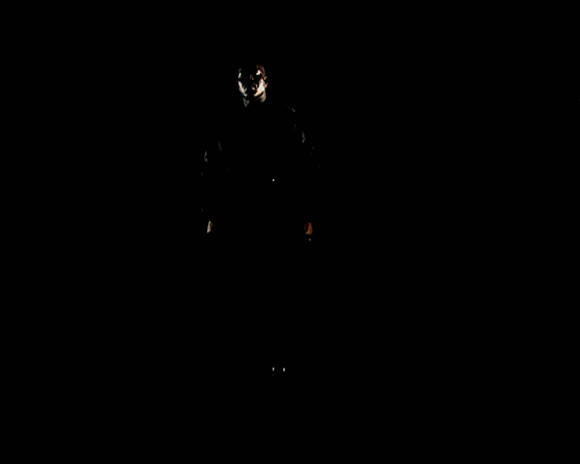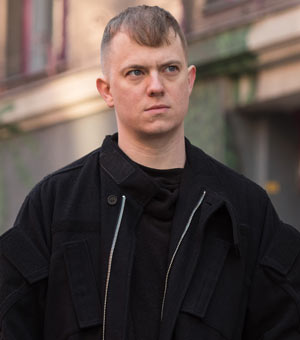Identity Drag
by Travis Jeppesen on May 1, 2010
With the advent of post-structuralist philosophy and the spread of issue-based political activism in the latter half of the 20th century, the problem of identity arguably emerged as the most pressing ideological issue of the Zeitgeist. While it also enabled the creation of a lot of bad art, a new exhibition in Berlin has triumphantly found a way to re-investigate the issue while avoiding the pitfalls of preachy didacticism. In the three video works included in “Angst.Macht.Raum,” the first of a proposed three-part exhibition exploring the mechanics of power, curator Viktor Neumann has put forth an intriguing test to the means by which fear is used to enforce oppressive codes of normality as Western discourse continues to expand its liberal doctrines, like a volcanic cloud, via globalization.
1974’s Ali: Fear Eats the Soul is probably the most well known film in the Rainer Werner Fassbinder oeuvre, if not one of the most cohesive. In characteristic fashion, the film virulently indicts the ugly racial tensions underlying relations between Germans and foreigners in 1970s West Germany – as well as the (namely working-) class prejudices that fueled them – through the story of a middle-aged German woman who becomes romantically involved with a younger Moroccan Gastarbeiter. In Angst Essen/Eat Fear (2008), the Singaporean artist Ming Wong has re-made the film into a 28-minute version in which he plays all the characters himself. The result is a stunning deluge of bitter ironies, as the notion of drag is expanded beyond cross-gender appropriation to encompass language, race, ethnicity, and nation. Wong himself is neither German, nor a native German speaker, nor white, nor Moroccan, etc.; yet Fassbinder’s script is stuck to verbatim. Thus, the entire notion of authenticity is shown to be a sham.
Through humor, Angst Essen/Eat Fear raises disturbing questions regarding the relationship between the contemporaneous trend of transnational fetishization and the continual process of globalization that has come to encompass life in the 21st century. It points to the trope of identity tourism that has also come to assume an important role in the work of video artist Ryan Trecartin, among others.
Also included in the exhibition is a selection of Sadie Benning’s earliest video works, made on a Fisher Price Pixelvision camera given to her by her father, filmmaker James Benning. These short pieces, stemming from the early 1990s, utilize a collage technique that would seem accomplished in the work of a seasoned artist, making it all the more surprising to learn that the artist was only fifteen when she made them. While the films bear a certain stylistic similarity to the super-8 movies being made by other queer underground filmmakers of that era (notably G.B. Jones and Bruce Labruce), Benning’s work lacks the intentionally grainy roughness of that medium and aesthetic, and was clearly made in the isolation of a teenage bedroom, rather than the street – thus implying a retreat from the larger world, a fear of the socius and everything that it threatens to impose on the individual body. The overall effect is of a diaristic coming-into-being and a refutation of the sexual stigmatism that queer adolescents often have to grapple with in silence.
The most frightening work on display, however, is Mike, a video installation by the Berlin-based artist Rommelo Yu, from 2002. Entering into a pitch-black room, the spectator is drawn forth by a sort of loud shuffling noise. The sheer darkness of the space already creates a fearful uncertainty and a sense of suspicion in the spectator – where does one go without getting hurt? Could it be that the projector has malfunctioned? – until a shadowy figure appears in the darkness, almost like a ghost. It is the image of a muscular black man, dimly lit, moving his feet every few seconds from one posture to the next. It is a deceptively simple installation. Only afterwards did it occur to me that it is about whiteness, which is a mode of being that stretches across races, a role that all of us are forced to play at some point in our lives in order to “pass” – a role that is formed and informed by fear.
Towards the end of his short life, Fassbinder wrote, “I always make the same film again and again, obviously…It’s a film about someone trying, with all the means that are possible in this society, to find his identity. Only the man who is really identical with himself can be free from fear of fear.”
The first part of “Angst.Macht.Raum” asserts that this existential struggle continues to define who we are and what we wish to become. It follows that in a post-everything world, those who appear the most certain are merely the most skillful in the art of deception.
“Angst.Macht.Raum. (Part 1)” is on through May 2nd at the Senatsreservenspeicher Berlin.


